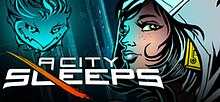
A tactical shooter is a sub-genre of first- and third-person shooters, associated with using strategy, planning, and tactics in gameplay, as well as the realistic simulations of ballistics, firearm mechanics, physics, stamina, and low time to kill. Dating back to strategy games from the late 1980s, the genre first rose to prominence in the late 1990s with the releases of several well-received tactical shooters. The popularity of the genre saw a decline in the late 2000s as fast-paced "arcade"-like action shooters rose to prominence, it has seen a revitalization since the mid-2010s with the successful releases of several modern tactical shooters.

Tom Clancy's Ghost Recon is a tactical shooter video game developed by Red Storm Entertainment and published by Ubi Soft in 2001 for Microsoft Windows. It is the first game in the Ghost Recon series. It was ported to Mac OS, Xbox and PlayStation 2 in 2002 and to the GameCube in 2003. Ports for N-Gage and Game Boy Advance were planned, but later canceled. Unlike Clancy's other tactical shooter series, Rainbow Six, Ghost Recon is not based on any of his books.
Shoot 'em ups are a sub-genre of action games. There is no consensus as to which design elements compose a shoot 'em up; some restrict the definition to games featuring spacecraft and certain types of character movement, while others allow a broader definition including characters on foot and a variety of perspectives.

Ikaruga is a shoot 'em up developed by Treasure. It is the spiritual sequel to Radiant Silvergun (1998) and was originally released in Japanese arcades in December 2001. The story follows a rebel pilot named Shinra as he battles an enemy nation using a specially designed fighter called the Ikaruga which can flip between two polarities, black and white. This polarity mechanism is the game's key feature and the foundation for its stage and enemy design. All enemies and bullets in the game are either black or white. Bullets which are the same color as the player are absorbed while the others will kill the player. The game features both single-player and cooperative modes.

Max Payne 2: The Fall of Max Payne is a 2003 third-person shooter game developed by Remedy Entertainment and published by Rockstar Games. It is the sequel to 2001's Max Payne and the second game in the Max Payne series. Set two years after the events of the first game, the sequel finds Max Payne working again as a detective for the New York City Police Department (NYPD), while struggling with nightmares about his troubled past. After being unexpectedly reunited with contract killer Mona Sax, Max must work with her to resolve a conspiracy filled with death and betrayal, which will test where his true loyalties lie.

Unreal II: The Awakening is a first-person shooter video game developed by Legend Entertainment and published by Infogrames under the Atari brand for Microsoft Windows, the game was later ported to Microsoft's Xbox console by Tantalus. It is the sequel to the 1998 video game Unreal and part of the franchise of the same name. Cliff Bleszinski was an executive producer for the title.

Kirby's Adventure is a 1993 platform game developed by HAL Laboratory and published by Nintendo for the Nintendo Entertainment System (NES). It is the second game in the Kirby series after Kirby's Dream Land (1992) on the Game Boy and the first to include the Copy Ability, which allows the main character Kirby to gain new powers by eating certain enemies. The game centers around Kirby traveling across Dream Land to repair the Star Rod after King Dedede breaks it apart and gives the pieces to his minions.
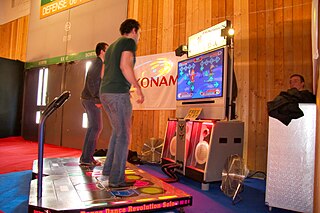
Rhythm game or rhythm action is a genre of music-themed action video game that challenges a player's sense of rhythm. Games in the genre typically focus on dance or the simulated performance of musical instruments, and require players to press buttons in a sequence dictated on the screen. Many rhythm games include multiplayer modes in which players compete for the highest score or cooperate as a simulated musical ensemble. Rhythm games often feature novel game controllers shaped like musical instruments such as guitars and drums to match notes while playing songs. Certain dance-based games require the player to physically dance on a mat, with pressure-sensitive pads acting as the input device.

The Darkness is a first-person shooter video game developed by Starbreeze Studios and published by 2K for the PlayStation 3 and Xbox 360. The game was released in 2007 in North America and Europe and it is based on The Darkness comic book series published by Top Cow Productions. A sequel titled The Darkness II was released in 2012.
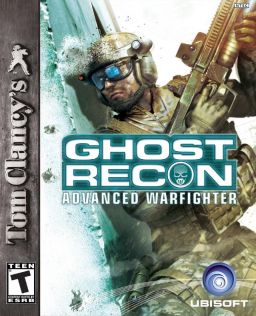
Tom Clancy's Ghost Recon Advanced Warfighter (GRAW) is a tactical shooter video game released for the Xbox 360, Xbox, PlayStation 2 and Microsoft Windows in 2006. As in previous Ghost Recon games, players command their team while neutralizing hostile forces and completing various mission objectives. These objectives can range from escorting friendly units across the map to rescuing hostages or taking out enemy artillery.
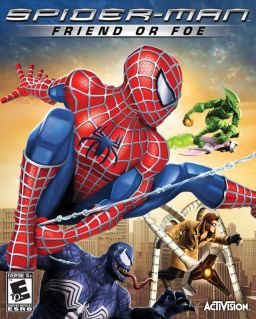
Spider-Man: Friend or Foe is a 2007 action-adventure beat 'em up platform game, based on the Marvel Comics character Spider-Man. The game borrows characters and designs from Sam Raimi's Spider-Man trilogy, with a plot that is non-canon to the films and therefore taking place within a divergent timeline where the villains seen in the films managed to survive. It features two player co-op gameplay, where one player controls Spider-Man and another one of his allies. The storyline of the game revolves around P.H.A.N.T.O.M.s, dangerous creatures created by mixing symbiotes with holographic technology, which a mysterious villain plans to use to take over the world. This villain has also captured and brainwashed many of Spider-Man's foes to help him acquire meteor shards that will strengthen his army. After being recruited by S.H.I.E.L.D., Spider-Man journeys across the globe to retrieve these shards himself and recruit more allies to his cause.

Fatal Frame III: The Tormented is a survival horror video game developed by Tecmo for the PlayStation 2. The third entry in the Fatal Frame series, it was published by Tecmo in 2005 in Japan and North America, and by Take-Two Interactive in Europe in 2006. Set after the events of the first two games, the story revolves around three characters who lost loved ones and are drawn into the supernatural Manor of Sleep. The gameplay revolves around exploring the Manor and tackling hostile ghosts using the Camera Obscura. Each character has different strengths and weaknesses, such as stronger attack or stealth elements.

Sleeping Dogs is a 2012 action-adventure video game developed by United Front Games and published by Square Enix. It was released for PlayStation 3, Xbox 360 and Windows. Set in contemporary Hong Kong, the story follows martial artist and undercover police officer Wei Shen who infiltrates the Sun On Yee Triad organization. Gameplay focuses on Wei Shen's martial arts moves, fighting, shooting and parkour abilities, and on gadgets that can be used for combat and exploration. Players must complete missions to unlock content and continue the story, but they may instead freely roam the game's open world environment and engage in both legal and criminal activities. The latter may incite a police response, the intensity of which is controlled by a "heat" system. Actions such as fighting, driving and racing grant Shen statistical rewards and earn the player achievements.

Red Dead is a series of Western-themed action-adventure games published by Rockstar Games. The first entry in the series, Red Dead Revolver, was released on the PlayStation 2 and Xbox in May 2004. Originally developed by Capcom, Red Dead Revolver borrowed elements from their 1985 arcade title Gun.Smoke, to which it was intended to be a spiritual successor, but the game was cancelled in 2002. Subsequently, after acquiring the rights, Rockstar purchased Red Dead Revolver and expanded on it.
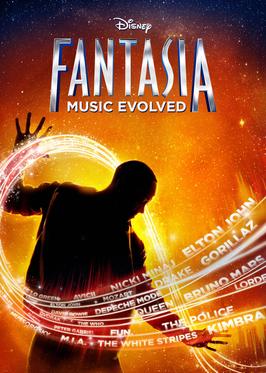
Fantasia: Music Evolved is a 2014 motion-controlled rhythm game developed by Harmonix and published by Disney Interactive Studios for the Xbox 360 and Xbox One with Kinect. The game is the interactive successor to Walt Disney Animation Studios' 1940 animated film Fantasia and its 1999 sequel Fantasia 2000, both of which it is based upon.
Superhot is an independent first-person shooter (FPS) video game developed and published by Superhot Team. Though the game follows traditional first-person shooter gameplay mechanics, with the player attempting to take out enemy targets using guns and other weapons, time within the game progresses at normal speed only when the player moves; this creates the opportunity for the player to assess their situation in slow motion and respond appropriately, making the gameplay similar to strategy video games. The game is presented in a minimalist art style, with enemies in red and weapons in black, in contrast to the otherwise white and grey environment.

Bloodborne is a 2015 action role-playing game developed by FromSoftware and published by Sony Computer Entertainment for the PlayStation 4. Bloodborne follows the player's character, a Hunter, through the decrepit Gothic, Victorian-era–inspired city of Yharnam, whose inhabitants are afflicted with a blood-borne disease which transforms the residents, called Yharnamites, into horrific beasts. Attempting to find the source of the plague, the player's character unravels the city's mysteries while fighting beasts and cosmic beings.
Enter the Gungeon is a 2016 bullet hell roguelike game developed by Dodge Roll and published by Devolver Digital. Set in the firearms-themed Gungeon, gameplay follows four player characters called Gungeoneers as they traverse procedurally generated rooms to find a gun that can "kill the past". The Gungeoneers fight against bullet-shaped enemies, which are fought using both conventional and exotic weapons. Enter the Gungeon features a permadeath system, causing the Gungeoneers to lose all obtained items and start again from the first level upon death. Between playthroughs, players can travel to an area called the Breach, where they can converse with non-player characters and unlock new items randomly encountered while playing.
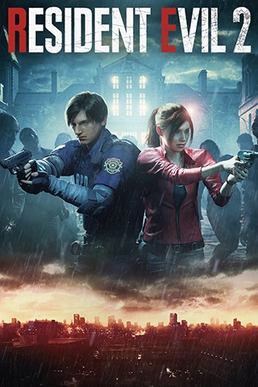
Resident Evil 2 is a 2019 survival horror game developed and published by Capcom. A remake of the 1998 game Resident Evil 2, it was released for PlayStation 4, Windows, and Xbox One in January 2019 and for Amazon Luna, PlayStation 5 and Xbox Series X/S in June 2022, and a Nintendo Switch cloud version released in November 2022. Players control the rookie police officer Leon S. Kennedy and the college student Claire Redfield as they attempt to escape Raccoon City during a zombie outbreak.

Hifuu Nightmare Diary ~ Violet Detector is the 16.5th Touhou Project game, released at the 94th Comiket on August 10, 2018. It is the third photography game in the series, and introduces regular shot types alongside the camera, allowing the player to switch between using photographs to destroy bullets, and regular danmaku to deplete enemies of their health.
